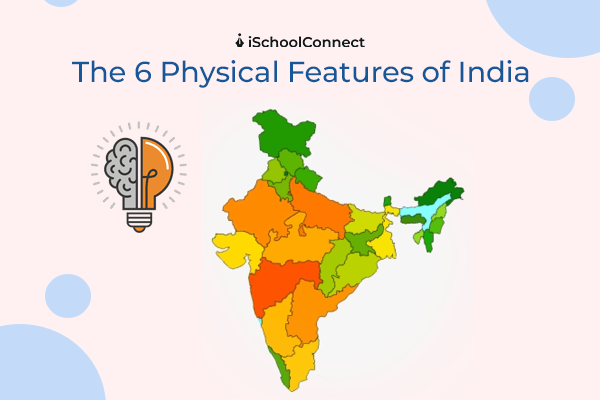Table of Contents
Physical features of India
Did you know you could wake up to misty mountains in Sikkim, spend your afternoon in the rolling plains of Punjab, and catch a sunset by the backwaters of Kerala – all in the same country? That’s India for you – a place where every turn brings a new landscape that’ll make your jaw drop!
India is now home to about 1.43 billion people as of 2024! That’s nearly 17.5% of everyone on Earth, making us the most populous nation in the world (yep, we recently overtook China!). We’re the seventh-largest country by land, but what’s even more exciting is how we’re sprinting ahead as one of the world’s fastest-growing economies.
Read More: Features of democracy | All you need to know!
But you know what really makes India special? It’s like nature decided to pack every kind of landscape into one amazing country! Imagine standing in the northern plains and looking up at the mighty Himalayas – our natural giant wall with China. Or venture northwest, where the Hindu Kush mountains keep us company, separating us from Afghanistan. And if you’re a wildlife enthusiast, oh boy, are you in for a treat! Let us tell you about some of our most incredible wildlife homes:
- Want to spot a majestic Bengal tiger? Head to Bandhavgarh or Kanha in Madhya Pradesh – these parks are like nature’s own reality shows!
- In Kerala, the Periyar Wildlife Sanctuary offers you a chance to watch elephants taking their evening bath.
- Up in Assam, Kaziranga is where you’ll find the amazing one-horned rhinos (it’s like stepping into a prehistoric world!).
- And if seeing the last remaining Asiatic lions is on your bucket list, Gir Forest in Gujarat is your go-to place.
- For something truly unique, the Kutch Wildlife Sanctuary in Gujarat shows you how life thrives in a desert ecosystem.
From snow-capped peaks to sun-soaked deserts, from dense forests to endless plains – India’s like a whole world wrapped up in one country. Pretty amazing, right? So, let’s delve deeper into the best physical features of India.
Ever wondered about the Operation Flood? Check out about the White Revolution in India
What Are The Physical Features Of India
The mountain ranges, plains, valleys, rivers, and islands all make up the physical features of India. Let us understand them in great detail.
The Himalayan Mountain Range
The Himalayan mountain range is one of the world’s most majestic and awe-inspiring physical features in India. The mountains are home to many beautiful plants and animals but can also be dangerous.
The Himalayas are home to some of the tallest mountains in the world: Mount Everest, Kanchenjunga, and Nanda Devi. They are also home to some of the most deadly animals on Earth: bears, tigers, and leopards.
The Himalayas were named after the Hindu god Himalaya by British explorer George Everest. The mountains run from Afghanistan through Pakistan, India, Nepal, Bhutan, and Tibet before ending in Myanmar (Burma).
Explore: IELTS Online Testing in 2025: Key Features & Preparation
The Northern Plains
The Northern Plains, also known as the Indo-Gangetic Plain, covers most of northern India. The plain extends from the Himalayas north to the Vindhya Range in central India. This area is also home to many cities with high populations, such as New Delhi and Lucknow, and is one of the oldest physical features of India.
The Indo-Gangetic Northern Plain is an important agricultural area because it has heavy rainfall during the monsoon season (July through September). As a result, the soil here is rich with nutrients that help crops grow quickly and produce abundant yields yearly without requiring much additional investment from farmers or other stakeholders involved in agricultural production processes (such as seed companies).
Do you know? What is the National Game of India? Hockey, Kabaddi or Cricket?
Indian Desert
The Indian Desert is the world’s 17th largest desert, covering about one-third of India’s land mass. The desert is home to many types of wildlife, including camels, wolves, jackals, and foxes. But it is also home to one of the unique plants on Earth: the baobab tree.
The baobab tree has a thick trunk that can grow over 75 feet tall and just as wide at its base. The tree stores water inside its trunk for long periods to survive without rain or other water sources. It also has deep roots that extend down into the ground, where they find moisture deep below the surface where other trees cannot reach it.
Peninsular Plateau
The Peninsular Plateau region in India is the most notable feature. Consisting of a vast, flat tableland with a central spine running north and south, it contains most of the country’s people and natural resources. The plateau map is bordered by the Aravalli Hills to the west, the Thar Desert to the north, and the Eastern Ghats to the east.
The plateau map contains fertile plains and large rivers like the Narmada, Godavari, Krishna, Kaveri, Tapti, and Mahanadi. These rivers flow north to south into peninsular India’s many lakes and estuaries.
Coastal Plains And Islands
India’s coastal plains and islands are among the most beautiful places in the world. The coasts are dotted with hundreds of islands, most of which are uninhabited. As a result, the beaches are some of the cleanest in the world and are often visited by tourists who want to escape it all. The Andaman Islands in the islands in the Bay of Bengal and the Lakshadweep Islands are the most well-known islands in India.
Read About: The first Indian Woman in Space | Kalpana Chawla
Rivers
India being an agro-based country, rivers hold utmost importance. It plays a significant role as a physical feature of the country, given its contribution to biodiversity. Ganga, Yamuna, Saraswati, Godavari, and Kaveri are some of the most prominent rivers in India.
Sanctuaries
Sanctuaries, on the other hand, provide shelter to animals like tigers and leopards, which are endangered species. In addition, sanctuaries are also popular tourist spots where people from all over the world come to visit them and see these beautiful animals in their natural habitat.
Explore: Top 5 Medical Colleges in India
Key Takeaways
The physical features of India are among the best salient features of the world’s physical geography, making it rich in terms of natural resources. With a long coastline, beautiful beaches, deserts, jungles, wildlife reserves, and glaciers, India is one of the world’s most diverse countries. For more insightful blogs like this, visit the iSchoolConnect website now!
Was this blog informative? If so, please share your thoughts in the comments below. Click here to reach out to us for more information on the different physical features of India. We would be happy to assist you with your queries!
Liked this blog? Read: Famous personalities of India
FAQs
Ques 1: What are physical features?
Answer 1: India is a land of diverse physical features. India has something for everyone, from its sandy beaches to the snow-capped Himalayas and coastal plains and islands.
Ques 2: Why are the physical features of India considered as important?
Answer 2: The physical features of India are considered essential because they directly impact the country’s economic growth. It helps in trade, agriculture, and other mining activities.
Ques 3: Which is the newest physical feature of India?
Answer 3: The Himalayas and the northern plains are the most recent landforms in India.
Ques 4: What are the granaries of the world?
Answer 4: The Prairies are known as the granaries of the world because of the huge production of wheat.






